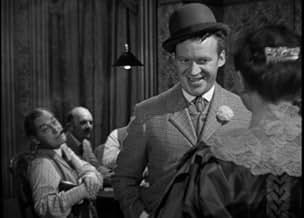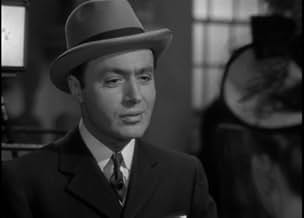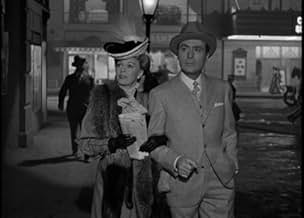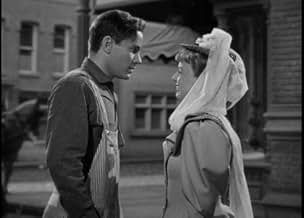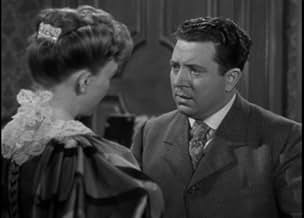AVALIAÇÃO DA IMDb
6,7/10
728
SUA AVALIAÇÃO
Adicionar um enredo no seu idiomaFive years after meeting and falling in love with a banker, a willful shop girl decides to become his mistress upon learning he has since gotten married and had a son.Five years after meeting and falling in love with a banker, a willful shop girl decides to become his mistress upon learning he has since gotten married and had a son.Five years after meeting and falling in love with a banker, a willful shop girl decides to become his mistress upon learning he has since gotten married and had a son.
- Direção
- Roteiristas
- Artistas
- Indicado a 1 Oscar
- 3 vitórias e 1 indicação no total
Eddie Acuff
- Andy
- (não creditado)
Dorothy Adams
- Mrs. Brown
- (não creditado)
William Alston
- Reporter
- (não creditado)
- Direção
- Roteiristas
- Elenco e equipe completos
- Produção, bilheteria e muito mais no IMDbPro
Avaliações em destaque
a moment. and its significance. love. and its force who change everything. and the need to respect the rules. one of the films who gives more than the flavor of old fashion cinema. but good performances, seductive - dramatic story, the bitter perspective about chance, choices and sacrifice, the opportunity to come back to a broken dream and the moral lesson who remains the perfect end. a love story who becomes game of memories. at the first sigh, this is all. but only the top of the iceberg. because Charles Boyer seems be perfect as the man looking for the true love. and he has the great gift to be part of beautiful cast who gives to story brilliance and profound roots.
Three great actresses, each in turn, Irene Dunne in 1931, Margaret Sullavan ten years later and Susan Hayward twenty years after that, took a shot at the role of Rae Smith, the protagonist of Fanny Hurst's popular novel "Back Street." Each tried her best to make sense of a perplexing character. Of the three actresses, Margaret Sullavan comes closest to putting it across. It's almost not fair to include Susan Hayward in the trio because for her the role was drastically rewritten. The others play more faithful versions. Rae Smith is a - I was about to say unique, but I cannot claim an encyclopedic literary knowledge - let us say, rare character. Scandalizing women abound in literature and film. None (at least I can't come up with any) are quite like Rae Smith. She is not a coquette like Manon, or a professional courtesan like Nana. She's not a poor girl seduced by the deviltry of a powerful man, like Faust's Margaret. She's not a conniver like Becky Sharp. She doesn't latch on to an otherwise intelligent man to destroy him, as Marlene Dietrich's Lola Lola in "The Blue Angel," or Arletty's Garance in "Les Enfants du Paradis," or Bette Davis' Mildred in "Of Human Bondage." She is a pure American type: an otherwise intelligent woman who lets a destructive man latch on to her. She ruins her life for love of a man who does not ruin his life for love of her. By the time Susan Hayward's turn came around that idea had become too grating. The story was twisted 180 degrees. Her Rae Smith refuses to surrender her life or her career for her man. He ruins his respectability, and loses his life, for her. That leaves Irene Dunne and Margaret Sullavan. Neither benefited from an indulgent screenplay. They had to struggle with the schizophrenia of their character. Rae is clearly possessed of a gifted and independent spirit. She blazes her way in a male-dominated world. Then she squelches that spirit, renounces her freedom, sacrifices all to the tedium of being a kept woman.
Why? Why does Rae efface herself, consent to live a life of clandestinity, no career, no children, no family, no friends except the man who enters, occasionally, for his pleasure? Margaret Sullavan comes closest to making sense of it all. She had an incomparable asset. Only one thing can plausibly account for Rae's self-destructive obsession. Only one thing can make her, every time she tries to break clear, act like a ball on a rubber string and bounce back to the stick that hits her. The man at the other end of the string must be a supremely attractive force. Irene Dunne had John Boles. He was a good actor and attractive in his way. (I, if I had been the casting director, would have switched him out for George Meeker who played against type as the goofy boyfriend Kurt.) Susan Hayward had John Gavin; we won't go there. Margaret Sullavan had Charles Boyer. Nobody among Hollywood's leading men could be more exotically romantic. Nobody could be more insidiously romantic. His ingratiating manner, his voice with its whiff of the foreign, easily projected a fatal attraction. It could hold in thrall otherwise strong-willed heroines: Ingrid Bergman in "Gaslight," Bette Davis in "All This and Heaven Too," Olivia de Havilland in "Hold Back the Dawn." I'm sure Margaret Sullavan saw that quality. Reportedly, she was so eager to have Boyer play opposite her in "Back Street" that she willingly yielded him the top billing. She was wise. Walter Saxel is a cad. He must be a mesmerizing cad, to imprison her, to hold her believably under his spell. Nobody could make a cad hypnotic better than Charles Boyer. Nobody could play a tormented heroine ("Three Comrades," "Cry Havoc") better than Margaret Sullavan (except perhaps Ida Lupino). She turns it on here full force, in her desperate look as she watches the steamboat carry Walter away up the Ohio, in her frantic reaction when she's hijacked by Frank Jenks' loathsome lothario, in her forlorn features as she sits in her paid-for hotel room after Walter's calamitous demise. Put that pair together before the camera, have them sit against a haystack and talk about the clouds. It makes even a story like "Back Street" work. It is unashamedly a tearjerker. It grates against modern sensibilities. But the chemistry of Sullavan and Boyer lifts it, though it takes some effort, past those liabilities. "Back Street" is worth a look for two great actors at their peak. If only Rae hadn't missed that steamboat ...
Why? Why does Rae efface herself, consent to live a life of clandestinity, no career, no children, no family, no friends except the man who enters, occasionally, for his pleasure? Margaret Sullavan comes closest to making sense of it all. She had an incomparable asset. Only one thing can plausibly account for Rae's self-destructive obsession. Only one thing can make her, every time she tries to break clear, act like a ball on a rubber string and bounce back to the stick that hits her. The man at the other end of the string must be a supremely attractive force. Irene Dunne had John Boles. He was a good actor and attractive in his way. (I, if I had been the casting director, would have switched him out for George Meeker who played against type as the goofy boyfriend Kurt.) Susan Hayward had John Gavin; we won't go there. Margaret Sullavan had Charles Boyer. Nobody among Hollywood's leading men could be more exotically romantic. Nobody could be more insidiously romantic. His ingratiating manner, his voice with its whiff of the foreign, easily projected a fatal attraction. It could hold in thrall otherwise strong-willed heroines: Ingrid Bergman in "Gaslight," Bette Davis in "All This and Heaven Too," Olivia de Havilland in "Hold Back the Dawn." I'm sure Margaret Sullavan saw that quality. Reportedly, she was so eager to have Boyer play opposite her in "Back Street" that she willingly yielded him the top billing. She was wise. Walter Saxel is a cad. He must be a mesmerizing cad, to imprison her, to hold her believably under his spell. Nobody could make a cad hypnotic better than Charles Boyer. Nobody could play a tormented heroine ("Three Comrades," "Cry Havoc") better than Margaret Sullavan (except perhaps Ida Lupino). She turns it on here full force, in her desperate look as she watches the steamboat carry Walter away up the Ohio, in her frantic reaction when she's hijacked by Frank Jenks' loathsome lothario, in her forlorn features as she sits in her paid-for hotel room after Walter's calamitous demise. Put that pair together before the camera, have them sit against a haystack and talk about the clouds. It makes even a story like "Back Street" work. It is unashamedly a tearjerker. It grates against modern sensibilities. But the chemistry of Sullavan and Boyer lifts it, though it takes some effort, past those liabilities. "Back Street" is worth a look for two great actors at their peak. If only Rae hadn't missed that steamboat ...
10machine2
This is my favorite movie of all times. It makes me cry, laugh, and hope. Rae makes your heart break for her. I never stop hoping that the ending will change. I know thats silly but...hey its a movie! Every woman should see this film if she is considering having an affair with a married man! I love all the versions but this is the best one! The ending just floors me each time I watch it.
the flavor from a lost period and manner to discover/invent reality, Charles Boyer in his classic character clothes,Margaret Sullavan looks, the drops of romance and drama, the pink crumbs and a decent acting are the pillars of that version. a version from the middle of war who use in smart manner the hope, love and a sentimental affair.maybe, it is not the best version. but it has a perfect cast for translate the story in right sentimental tone. that fact is really important because it reminds the flavor of a world. and the result is a kind of gem. not very precious, not exactly unique but nice at whole. a film for rainy afternoons and Sunday evening. like an old love song.
Margaret Sullavan is one of my all-time favorite actresses with her husky voice and haunting screen presence. The original version in 1932 with Irene Dunne and John Boles was dull and stage-bound; the later version with Susan Hayward was just too gaudy. This is the version to watch!
Margaret gives an exquisitely heart-rending performance as a turn-of-the-century miss who falls in love with a man (played by the smooth but oh-so-serious Charles Boyer). Fate intervenes and the two lovers are separated. They meet again years later, but, true to the classic weeper formula, he is married. Despite her better judgment, she carries on a "Back Street" romance with him for many years until their untimely demises.
Promoted with the tag line, "If you have tears, be prepared to shed them", this movie does involve some suspension of disbelief. For example, for such a level-headed gal, why does Margaret allow Boyer to treat her so shabbily? Just when I am about to shake my head and yell "Why?", Margaret then either let loose with the tears or try to hide the choking sob in her voice, and I'm transfixed all over again.
This film does feature solid direction, beautiful photography and some good supporting performances (I particularly liked Frank McHugh in this one). This film remains on my "Wish-They-Release-This-One-on-Video" list.
Margaret gives an exquisitely heart-rending performance as a turn-of-the-century miss who falls in love with a man (played by the smooth but oh-so-serious Charles Boyer). Fate intervenes and the two lovers are separated. They meet again years later, but, true to the classic weeper formula, he is married. Despite her better judgment, she carries on a "Back Street" romance with him for many years until their untimely demises.
Promoted with the tag line, "If you have tears, be prepared to shed them", this movie does involve some suspension of disbelief. For example, for such a level-headed gal, why does Margaret allow Boyer to treat her so shabbily? Just when I am about to shake my head and yell "Why?", Margaret then either let loose with the tears or try to hide the choking sob in her voice, and I'm transfixed all over again.
This film does feature solid direction, beautiful photography and some good supporting performances (I particularly liked Frank McHugh in this one). This film remains on my "Wish-They-Release-This-One-on-Video" list.
Você sabia?
- CuriosidadesA contemporary article in the Los Angeles Examiner stated Joan Fontaine was originally cast in the female lead, but she was replaced by Margaret Sullavan before shooting began.
- Erros de gravaçãoIn the closing sequences, which are supposed to be taking place in 1928, all of the women's hair styles and clothes, particularly those of Nell O'Day, and especially Margaret Sullavan's square-shouldered fur cape, are strictly contemporary 1941.
- ConexõesFeatured in The Universal Story (1996)
- Trilhas sonorasAuld Lang Syne
(uncredited)
Traditional Scottish music
Lyrics by Robert Burns
Sung by New Year's Eve party revellers
Principais escolhas
Faça login para avaliar e ver a lista de recomendações personalizadas
- How long is Back Street?Fornecido pela Alexa
Detalhes
- Data de lançamento
- País de origem
- Idioma
- Também conhecido como
- Back Street
- Locações de filme
- Empresa de produção
- Consulte mais créditos da empresa na IMDbPro
- Tempo de duração1 hora 29 minutos
- Cor
- Proporção
- 1.37 : 1
Contribua para esta página
Sugerir uma alteração ou adicionar conteúdo ausente


